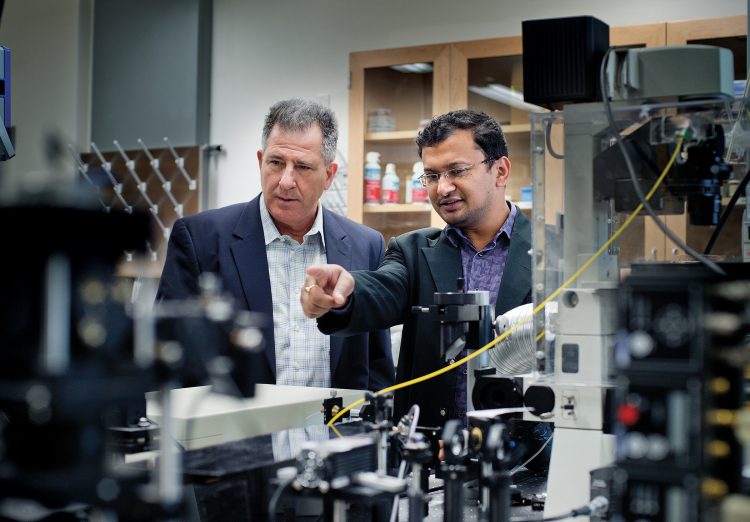UT Arlington nanoparticles could provide easier route for cell therapy

Physics Professor Ali Koymen, left, and Samarendra Mohanty, an assistant professor of physics, discuss their research.
In a study published recently by the journal Nature Scientific Reports, the team paired crystalline magnetic carbon nanoparticles and continuous wave near-infrared laser beams for in what is called photothermal delivery. Authors of the new paper are Ali Koymen, a professor of physics; Samarendra Mohanty, an assistant professor of physics; and Ling Gu, a researcher in Mohanty’s lab.
The new discovery grew out of previous study where Koymen and Mohanty used a 50 to 100 milliwatt laser and the same carbon nanoparticle, which absorbs the beam, to heat up and destroy cancer cells in the lab. The team used the new photothermal delivery method in lab experiments to introduce impermeable dyes and small DNA molecules into human prostate cancer and fibroblast sarcoma cells.
“In this work, Dr. Mohanty used a lower power, 20 to 30 milliwatt, continuous wave near-infrared laser and the nanoparticle to permeate the cell membrane without killing the cells. This method stretches the desired cell membrane to allow for delivery and has the added bonus of creating a fluid flow that speeds the movement of what is being delivered,” said Koymen, whose lab created the study’s crystalline magnetic carbon nanoparticle using an electric plasma discharge inside a toulene solution.
Introducing foreign DNA or other small molecules directly into cells is essential for some of the most advanced methods being developed in gene therapy, vaccinations, cancer imaging and other medical treatments. Currently, the predominant practice is using viruses for delivery to cells. Unfortunately, the scope of what can be delivered with viruses is severely limited and virus interaction can lead to inflammatory responses and other complications.
Scientists looking to create a path into the cell without employing a virus also have experimented with using UV-visible light laser beams alone. But that method damages surrounding cells and has a relatively shallow level of effectiveness.
A significant advantage of the new method is that the near-infrared light absorption of the nanoparticle can be used to selectively amplify interaction of low power laser with targeted tissue and “laser induced-damage to non-targeted cells along the irradiation path can be avoided,” the report says. The magnetic properties of the nanoparticles also mean they can be localized with an external magnetic field; therefore a smaller concentration can be used effectively.
“Research universities like UT Arlington encourage faculty and students to follow each new discovery with even deeper questions,” said Pamela Jansma, dean of the UT Arlington College of Science. “With their latest publication, Drs. Koymen, Mohanty and Gu have taken their collaboration to a new level as they keep building toward valuable implications for human health and disease treatment.”
Carbon nanoparticles produced for the cancer study varied from five to 20 nanometers wide. A human hair is about 100,000 nanometers wide. The magnetic carbon nanoparticles also are fluorescent. So, they can be used to enhance contrast of optical imaging of tumors along with that of MRI.
Mohanty’s lab is supported by funding from the National Institutes of Health and the National Science Foundation.
About UT Arlington
The University of Texas at Arlington is a comprehensive research institution and the second largest institution in The University of Texas System. The Chronicle of Higher Education ranked UT Arlington as the seventh fastest-growing public research university in 2013. U.S. News & World Report ranks UT Arlington fifth in the nation for undergraduate diversity. Visit www.uta.edu to learn more.
The University of Texas at Arlington is an Equal Opportunity and Affirmative Action employer.
Media Contact
More Information:
http://www.uta.edu/news/releases/2014/06/koymen-mohanty-paper.phpAll latest news from the category: Life Sciences and Chemistry
Articles and reports from the Life Sciences and chemistry area deal with applied and basic research into modern biology, chemistry and human medicine.
Valuable information can be found on a range of life sciences fields including bacteriology, biochemistry, bionics, bioinformatics, biophysics, biotechnology, genetics, geobotany, human biology, marine biology, microbiology, molecular biology, cellular biology, zoology, bioinorganic chemistry, microchemistry and environmental chemistry.
Newest articles

Silicon Carbide Innovation Alliance to drive industrial-scale semiconductor work
Known for its ability to withstand extreme environments and high voltages, silicon carbide (SiC) is a semiconducting material made up of silicon and carbon atoms arranged into crystals that is…

New SPECT/CT technique shows impressive biomarker identification
…offers increased access for prostate cancer patients. A novel SPECT/CT acquisition method can accurately detect radiopharmaceutical biodistribution in a convenient manner for prostate cancer patients, opening the door for more…

How 3D printers can give robots a soft touch
Soft skin coverings and touch sensors have emerged as a promising feature for robots that are both safer and more intuitive for human interaction, but they are expensive and difficult…





















